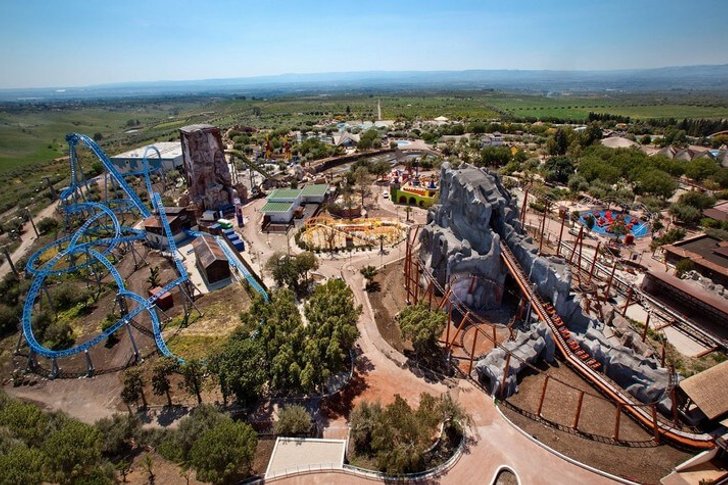The whole history of Catania took shape in the shadow of the formidable and majestic volcano Etna. The mountain, like an almighty deity, rises above the city and does not let you forget how perishable everything created by man is. Several times the city turned into ruins due to earthquakes, but again rose from the ashes like an immortal phoenix.
Catania is an ideal place not only for lovers of the colorful Italian province, but also for connoisseurs of the magnificent Baroque. Almost all city buildings were erected in this manner, which is why the streets and squares give the impression of integrity and unity of style.
But not only the churches and the Palazzo of Catania attract tourists here: gourmets rush to the main fish market, where delicious seafood is sold, and fans of ancient culture go to museums with Roman and Greek artifacts.
What to see and where to go in Catania?
The most interesting and beautiful places for walking. Photos and a short description.
- Mount Etna
- Cathedral Square
- Cathedral of Saint Agatha
- Fish market
- Via Etnea
- Via Crociferi
- Monastery of the Benedictines
- Church of St. Nicholas
- Collegiate basilica
- Church of Saint Benedetto
- Museum of the Allied Landings in Sicily
- Teatro Massimo Bellini
- Roman theater and odeon
- Roman amphitheater
- Ursino Castle
- Palazzo Biscari
- Botanical Garden
- Villa Bellini Park
- San Giovanni Lee Cuti
- Etnaland
Mount Etna
An active volcano on the island of Sicily, which quite often frightens residents with its seismic activity. The last strong eruption was recorded in February 2017. The volcano has several hundred craters, from which red-hot lava regularly pours out, which is why the authorities are forced to close the international airport. The mountain is located near Catania and Messina.
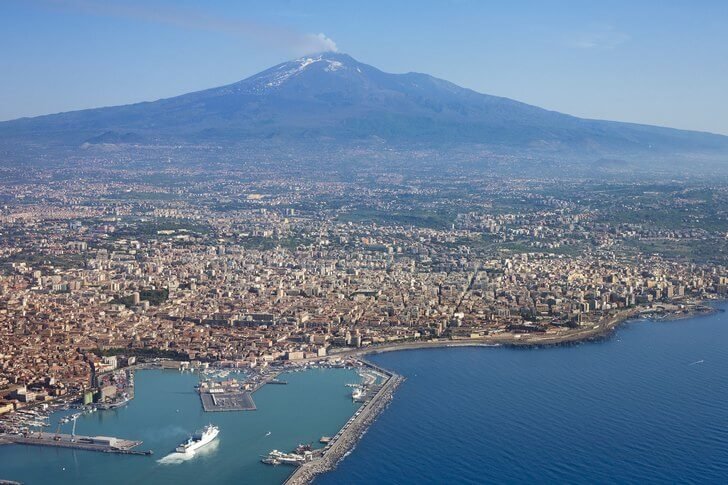
Cathedral Square
The center of city life and a place with centuries of history. The square is surrounded by magnificent baroque buildings, which were created by the talented master DV Vaccarini. Here are the city gates, the cathedral, the town hall and the famous fountain "Elephant" - the symbol of Catania. Even the indigenous people cannot answer the question of where the sculpture of this exotic animal came from in the middle of the city.
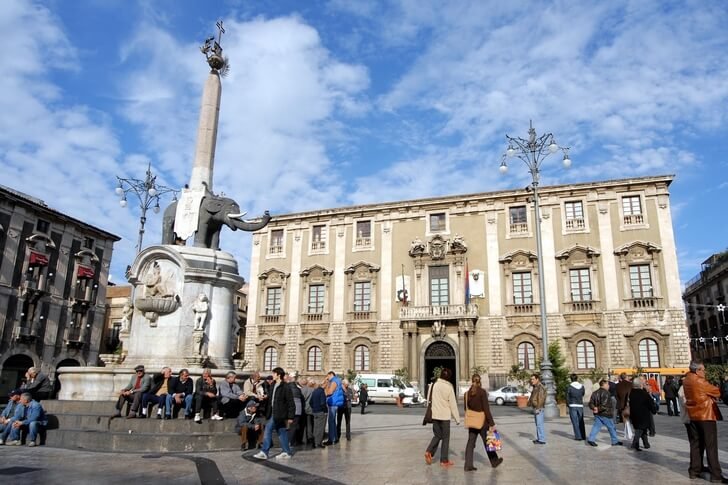
Cathedral of Saint Agatha
St. Agatha is considered the patroness of Catania. The townspeople sincerely believe that she protects their homes from the restless and formidable Etna. The first temple building was erected on the ruins of Roman baths in the 11th century. This building was more like a military fortress. Twice as a result of strong earthquakes the cathedral was in ruins. The building acquired its present appearance at the beginning of the 17th century. The architect D. V. Vaccarini gave it the magnificent features of the Sicilian Baroque.

Fish market
At the market, you can buy all the seafood delicacies that the fishermen of the Tyrrhenian and Ionian Seas bestow. Mussels, sea snails, shrimp, squid, octopus, not to mention countless types of fish, ranging from microscopic to giant tuna and swordfish. It also sells fresh vegetables, olives, cheese, fruits, meat products and alcoholic beverages.
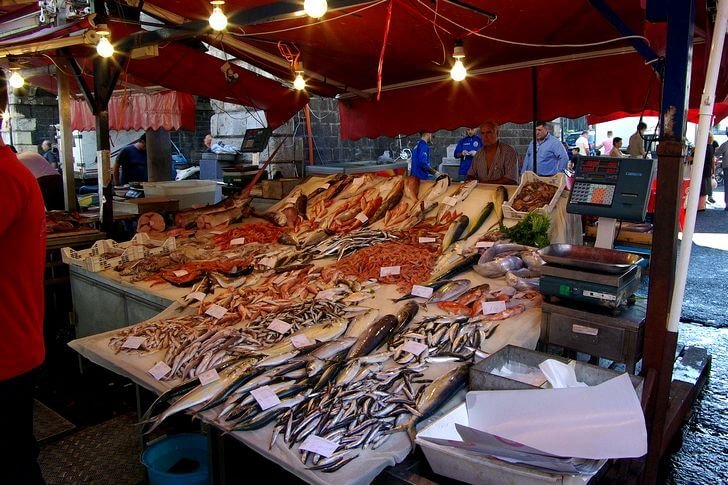
Via Etnea
The main street in the historic center of the city, which stretches from Duomo Square. The alley appeared in the 17th century, when Catania was practically restored from ruins after another earthquake. Via Etnea is lined on both sides by picturesque Sicilian Baroque palazzos, churches and public buildings. The pavement street is lined with lava cobblestones, which were brought from Etna.
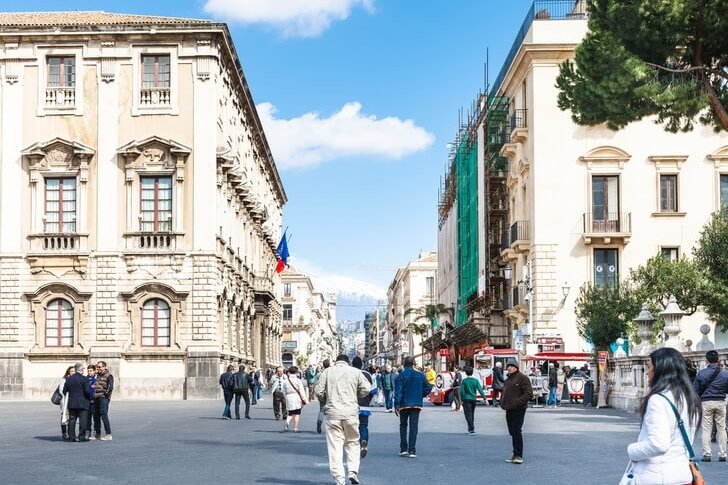
Via Crociferi
The street runs along the 18th century road from Piazza San Francesco Assisi. The alley is decorated with historical buildings and ancient churches. As on Via Etnea, almost all buildings were built after the earthquake of 1693 in the Sicilian Baroque style. D. V. Vaccarini worked on the projects of many buildings. Via Crociferi is considered the architectural gem of Catania and all of Sicily.

Monastery of the Benedictines
The monastery is located in the historical center of Catania. It is believed that its construction began in the 16th century (according to another version - in the 14th). At one time the monastery was one of the richest in Europe. Today the complex is included in the UNESCO World Heritage List. A university is located on its territory: professors' offices are organized in the former cells, classrooms are located in the churches.
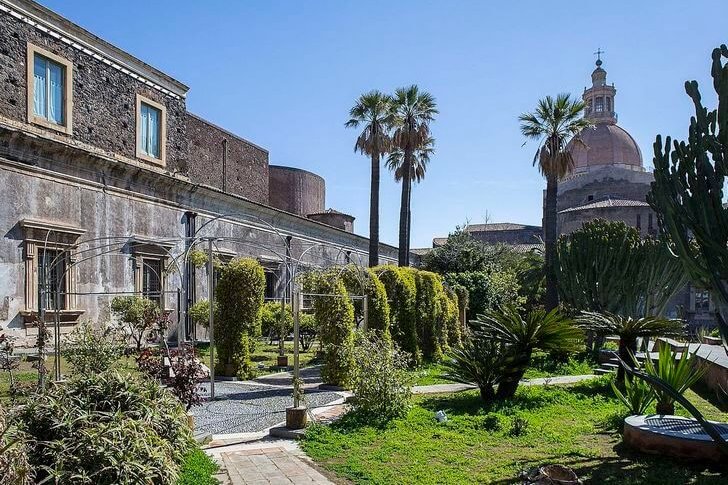
Church of St. Nicholas
The temple is located west of Piazza Dante. Its construction began in 1687, but a few years later there was an earthquake and the work could not be completed. The church has survived to this day in an unfinished form with a grandiose colonnade that does not support anything, and an unlined facade. At the same time, the interior gives the impression of completeness.
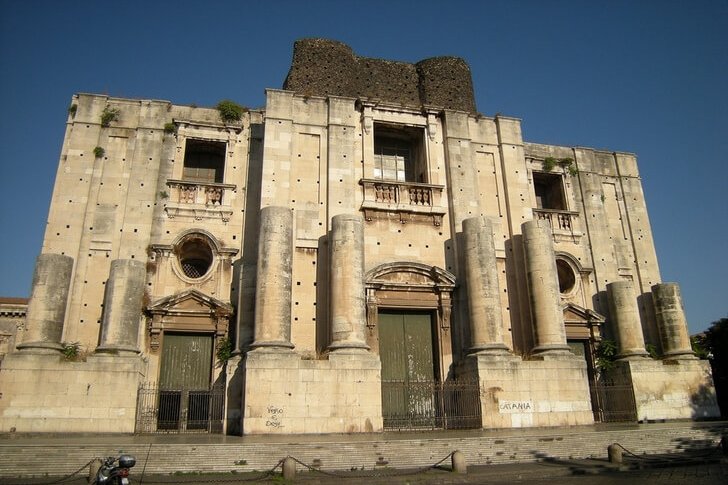
collegiate basilica
The temple is dedicated to the Madonna of Mercy. The building, or rather its main facade, by S. Ittar, is one of the best examples of Sicilian Baroque. The basilica was erected at the end of the 17th - beginning of the 18th centuries on the site of a chapel destroyed by an earthquake. The building fits perfectly into the urban landscape, forming the architectural appearance of the historical center of Catania.
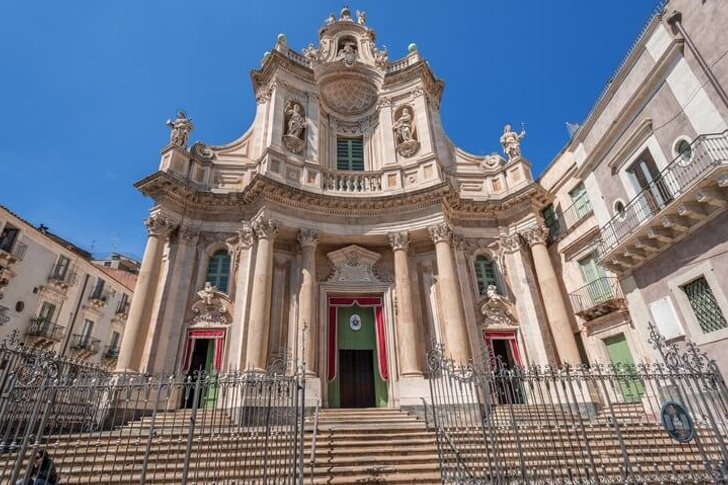
Church of Saint Benedetto
The temple is part of a large monastic complex. It was built at the beginning of the 18th century in the Baroque style. The interior is richly decorated with precious stones and painted with frescoes by eminent masters. Inside there is a marble "stairway of angels" lined with graceful statues. The Church of St. Benedetto occupies a special place among all the temples of Catania.

Museum of the Allied Landings in Sicily
In the summer of 1943, troops of the anti-Hitler coalition landed in Sicily (the strategic operation "Husky"), as a result of which the island was captured and liberated from the fascist regime of Mussolini. The exposition of the museum is dedicated to this significant event. Photographs, uniforms and weapons of the enemy armies, documents and other exhibits that tell about the course of the operation are exhibited here.

Teatro Massimo Bellini
The opera stage, named after the composer V. Bellini, a native of Catania. They thought about the construction of the theater at the beginning of the 19th century, but the building was erected only in 1890. The maestro's opera "Norma" became the premiere production. The ceiling of the auditorium of the theater is painted with scenes from the most famous works of Bellini, and the front foyer is decorated with his statue. The building was built in the Baroque style.
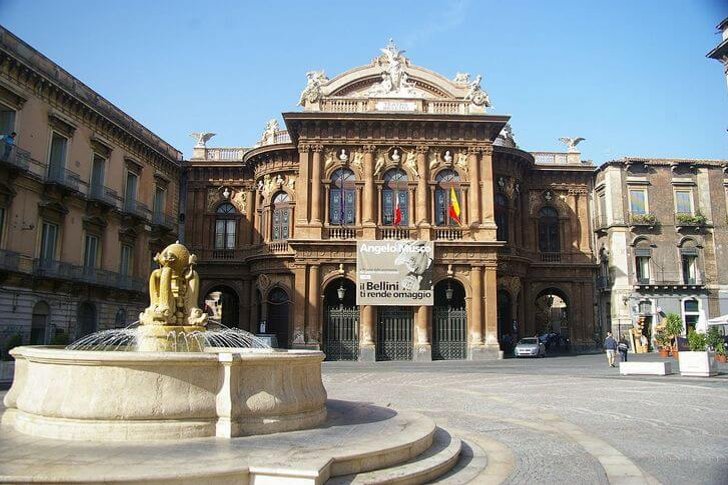
Roman theater and odeon
The Roman theater arose on the site of the Greek in the II century. The Romans not only significantly expanded the stage, but also attached an odeon to it for 1.5 thousand spectators. By the 6th century, the building had fallen into disrepair. In the Middle Ages, its walls, blocks and decorative elements began to be taken away for the construction of temples. As a result, the theater was surrounded by buildings, streets were laid through it, which finally contributed to its destruction. The scene was discovered in the 19th century during excavations.
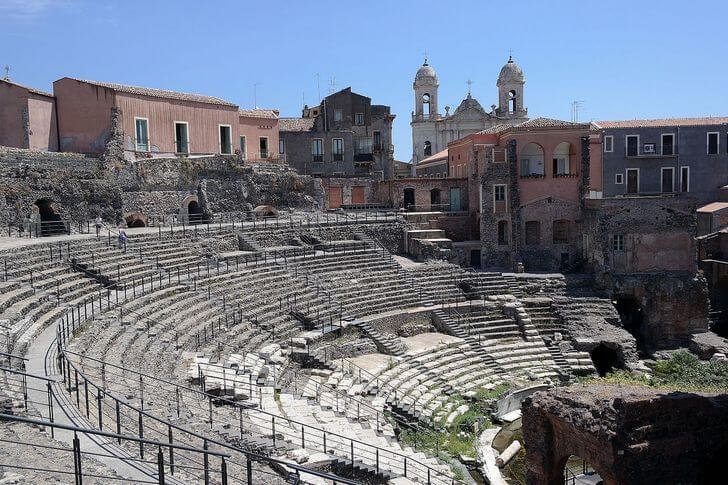
Roman amphitheater
The amphitheater was erected in the II century on the northern outskirts of the city. Its stands were designed for 15 thousand spectators. After losing its original meaning, it was used as a quarry for a long time. The earthquake of 1693 completed the destructive work and razed the amphitheater to the ground. It was discovered during excavations in the 18th century. Since 1907, the ruins have been open to the public.

Ursino Castle
Medieval fortress of the 13th century with powerful walls and towers. Once the building was of strategic importance - from here the control over the eastern coast of Sicily was exercised. Today, on the territory of the bastion there is a museum with archaeological artifacts of the ancient era and a collection of Sicilian paintings. The last reconstruction of the Ursino fortress was carried out in the 1930s.

Palazzo Biscari
Private mansion of the Dukes of Biscari, built in the second half of the 18th century. The architects A. Benedetto, D. Palazzotto, and F. Battaglia worked on the project of the building. The luxurious palace is made in the rococo style, which is distinguished by the splendor and pretentiousness of the interiors, as well as an incredible abundance of decor. The interior decoration of the halls emphasizes the grandeur and wealth of the Biscari family.
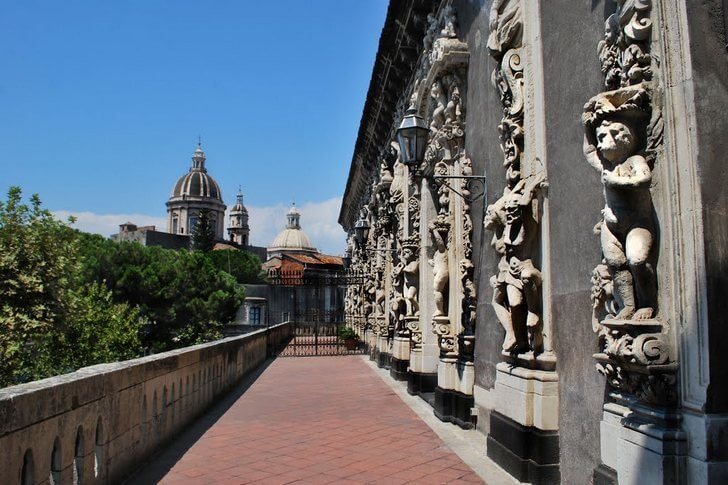
Botanical Garden
The botanical garden belongs to the local university. It was founded in the middle of the 19th century by the Benedictine monk F. Tornabene. The territory of the garden is divided into two parts. In the first, exotic species from all over the world grow, the second (smaller) is reserved for representatives of the Sicilian flora. In total, more than 2 thousand plant samples have been collected here, among them several dozen palm trees.
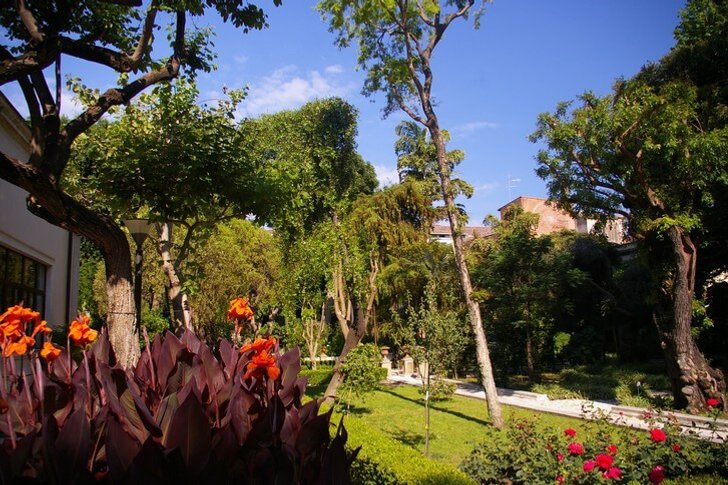
Villa Bellini Park
The park is located next to Via Etnea in the city center on two symmetrical hills connected by alleys and stairs. It was named after the composer Bellini. There are fountains, artificial reservoirs, sculptures, beautifully decorated flower arrangements and other elements of landscape design. In hot weather, in the park you can hide from the scorching sun in the shade of exotic trees.
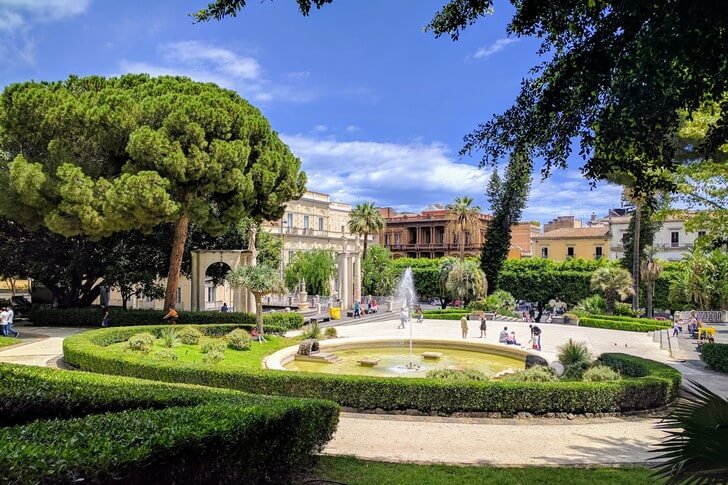
San Giovanni Lee Cuti
Rocky beach formed from solidified magma. Because of the stones, it is quite difficult to enter the water, so the place is not recommended for children. In the high season, for the convenience of tourists, a descent into the water is installed here. The infrastructure of San Giovanni Li Kuti is rather poorly developed. However, all the shortcomings are compensated by the magnificent nature and picturesque views from the beach.

"Etnaland"
A large amusement park at the very foot of Mount Etna, created in the early 2000s. It is designed for visitors of all ages. There is a water park with different types of slides, a dinosaur park with huge models of prehistoric monsters and a special area where spectacular laser shows are held. Near "Etnaland" there is an extensive shopping area and places for recreation.
